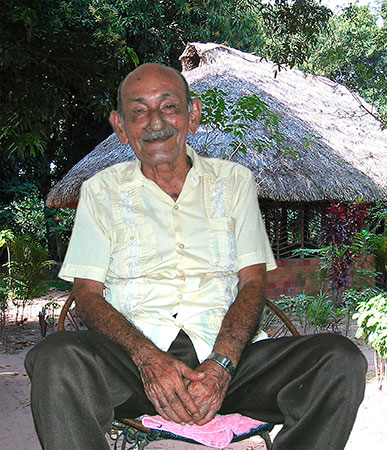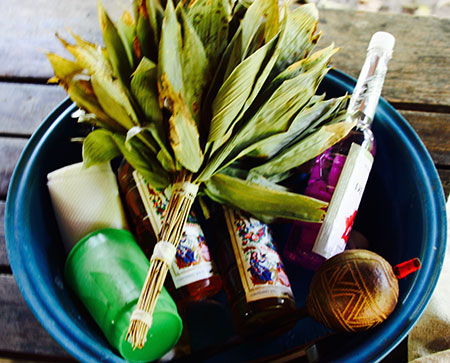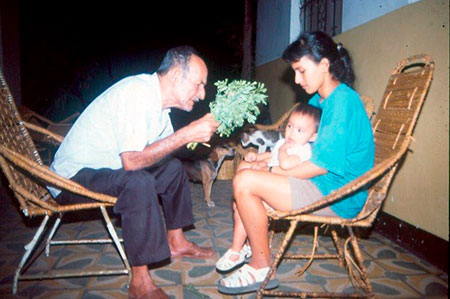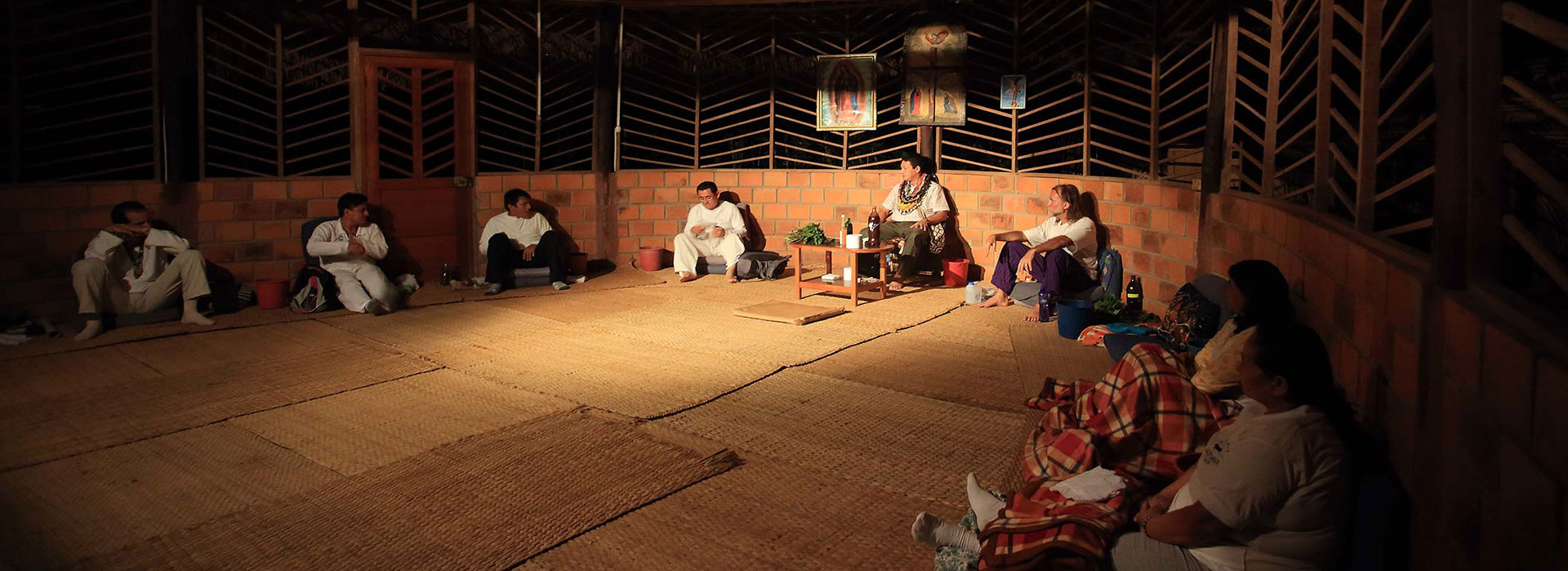Summary
The high effectiveness of the therapeutic procedures used in traditional medicine is currently generating great interest in the Western world. Attempts are made to reduce the efficacy of these procedures, on one hand to the biochemical properties of plants and on the other hand, to the use of suggestive techniques by healers, which is why Westerners strive to learn these "techniques" without paying attention to the rigorous initiatory process, that is required to learn and practice traditional medicine.
The tradition
Master healers consider the art of healing as a gift, that comes from God, through the spirits of the plants. That is the reason why traditional doctors hardly ever charge for their services. Instead, they often ask their patients to bring or leave "at their will” what they consider the service is worth, so it is usually paid with money or with provisions. It may be possible to think or come to the conclusion that the art of healing is a manifestation of the inner nature, the unconscious side of one person, and that it is not the product of a rational decision, premeditated or accountable to the fact that nowadays it is fashionable to be a healer.
What we have observed, according to our experience and contacts with master healers (ayahuasqueros, tabaqueros, perfumeros, purgueros y sobadores), is that the gift or the call manifests itself at the precise moment that they are going through an illness and treated. Therefore, the healers first are patients, who have gone to the doctor to be treated for some physical or spiritual illness. During this therapeutic work, that involves the intake of plants with psychoactive effects, such as ayahuasca, during night sessions, or other master plants in a very special and rigorous condition called “Dieta” (diet), intended to heal, the spirit manifests to them through dreams or visions where he tells them how they will heal, what kind of plants they will use, what icaros or verses they will sing, what type of diseases they will be able to cure.
Through the healing-learning process the person will discover his art, method and specialty. Throughout the process he will be accompanied by his master - guide. In the Amazon it is not possible to conceive the intake of master plants without a guide, a teacher who helps us re-find our way. When the gift manifests itself masters often say "the plant loves you", and it is them who invite the apprentice to continue taking the master plants, this time no longer to cure the illness with which one came, but to start the learning process.

The teaching process
In opposition to what our Western, rational thinking believes and expects, the transmission of knowledge occurs in a nonverbal way. The learning method is almost a personal, experience-based process, in which the subject will learn through three fundamental procedures:
1. Ayahuasca
In the Amazonian mestizo tradition, the process begins when the apprentice is invited by his master to take ayahuasca. This brew is the result of the decoction of two plants: the vine called ayahuasca (banisteriopsis caapi) and the leaves of a bush called chacruna (psychotria viridis). These are nocturnal sessions, at dark, in which, after having ingested the plant, the master who runs the session will sing his icaros, healing songs that guide the effect of ayahuasca, also known as mareación (dizziness). The apprentice will enter into a process of dizziness in which he will continue to work and metabolize his personal aspects to be cleansed and healed. Through the icaros of the healer, he will be taken to the world of master plants, great healers, medicine, and Amazonian cosmovision. He will be able to gain knowledge of the therapeutic use of plants in its various aspects, that according to his personal evolution at some point can lead him be a good healer or a great wizard.
During the same ayahuasca session, the master healer will call the apprentice to sing him an “icaro”, so to cure him individually. Through this procedure, the teacher will cleanse his body, arrange his diet and give him his defense weapons, the “arcanas”. The master prepares the body and mind of his disciple for what he will have to face in the future when he will begin to heal. Then he blows him with tobacco smoke or perfume in several energetic points such as the crown of the head, back, chest and hands. At the end of this healing session, the teacher will give some recommendations regarding what foods to avoid, how long the required sexual abstinence will last and some other tips regarding the learning process.
The “icarada” will be repeated later in different occasions, even outside the context of ayahuasca, since through this medium all the work that is being done is ensured. After frequent takings of ayahuasca, “dietas”, and some years after having initiated the process the teacher will invite the student to accompany him singing the icaros he sings in ayahuasca sessions, later he can sing alone but only the icaros of the teacher and eventually even his own icaros perhaps obtained during ayahuasca sessions, in his dreams or in the “dieta”. Ayahuasca is the gateway to the world of plants and medicine. It is through it that you learn the medicinal properties of plants, that you learn various therapeutic tools such as “sopladas” (tobacco smoke blows), massages, taking and interpreting the pulse, using perfumes, tobacco and other resources that will then be used in healing sessions.
Master healers consider the art of healing as a gift, that comes from God, through the spirits of the plants. That is the reason why traditional doctors hardly ever charge for their services.
There is no exact timeframe indicating from what date in the process of teaching the pupil may he conduct healing sessions of ayahuasca. Usually a student has to go live with the teacher a while or visit him from time to time in order to prepare and learn. Anyway, teachers usually recommend that students begin curing without giving ayahuasca, instead by blowing tobacco smoke or singing icaros to children because their energy is less charged than that of adults. When the time arrives for him to lead his own sessions it will be on proposal of the teacher who will accompany him in the first sessions, then after these evaluation sessions he will be authorized to direct his own ayahuasca healing sessions.
2. The "dieta" (diet)
A therapeutic practice within the traditional Amazonian medicine that consists of making a retreat to the jungle, where the so-called master plants will be ingested in the hand of the teacher in quite rigorous and austere conditions. The disciple will be installed in a tambo or single-person hut for the duration of the dieta. Depending on the chosen master plant it will be taken in the morning and / or afternoon. It is allowed to eat only parboiled rice, green bananas, or a type of fish as food. These foods will be cooked without any seasoning, without salt or sweets. You can have contact only with the teacher and not with any other person, since the absence of salts and sweets, plus the fact of taking the plant, make the person very sensitive and vulnerable, their energy field being open. If you come in contact with a woman who is menstruating, with a sick person, or someone who has had sexual intercourse or is using toxic substances, the results can be very dangerous for the dieter, that is why dietas are performed in distant places within the jungle.
The dieta is a procedure that is performed for two specific purposes, for healing or for learning. Conventional medical services are scarce in the Amazon rainforest and are often not available to the population for economic reasons and because they are often not at hand. People who become seriously ill tend to resort to the plant doctor or healer who, after an evaluation, may recommend a dieta. The duration of the dieta will be indicated by the teacher and will also be dependent on the illness, it can be from 8 days to 6 months, or a year. The dieta as a learning process to become a healer also has the same conditions already mentioned. The only difference is that the plant chosen by the teacher will aim to give the apprentice more sensitivity, more intuition, put defenses in his body, learn to cleanse or purge and learn his icaros.
The learning process in the dieta will be mainly through dreams. The apprentice will get in touch with the mother spirit of the plant that he is dieting who will teach him his healing song, the icaro, and how to use it. Due to the great sensitivity of the person during the dieta he can make contact in his dreams with the spirit of other plants where he will also learn how to use them and how to manage them. Depending on the sensitivity of the person, he can learn other skills such as “pulsear”: a technique in which taking the pulse of the patient can reveal what type of disease he has and whether it corresponds to a common disease or it was induced by harm or bad people. Another skill is the “sobada”, by which the “sobador”, a body massager, becomes an empirical chiropractor.
During the dieta the apprentice will also go through tests in which he will often be tempted to abandon the dieta or end the process, he will go through periods of discouragement and boredom, he won´t tolerate to have another austere meal and will want to eat sweets or some fruit, he may feel that it is not worth so much effort and sacrifice. It may be that the plant does not manifest from the beginning or that he does not have dreams. Many situations can happen, to which healers usually say: "you are being tested by the plant". It´s up to the apprentice to face the temptation of power, of pride. The plants try us and hit us in our weak points, such as ego inflation.
During the dieta the other side of learning is also manifested, the dark side. Within the conception of learning for healers there is good and evil. There exists a type of learning that teaches to manipulate the energy of plants, and of people. Therefore, we consider that, within a process of learning in the context of the mestizos, this must be followed by a process of personal evolution with permanent accompaniment of the teacher who will closely follow his student to ensure that his energy does not get "twisted”.

Finally, after the days of retirement in the jungle and ingesting the master plant, comes the so-called diet cut. The teacher will sing an icaro to his disciple and then blow with black tobacco smoke in order to close the energetic body which was opened in the dieta process. With the blow it puts an end to the very rigorous conditions that he had to face, however he will have to stay a few more days in the jungle until he metabolizes the diet cut. Followed by the tobacco blow he will eat a salad of onion, lemon, garlic, salt and a little chili, and pass on to take a broth of farmed chicken. This ends the abstinence of salt. After the diet cut, the teacher will give some indications to follow which still carry enough rigor, such as the amount of time that he will be in abstinence from sweets (sugars and fruits), sexual abstinence, abstinence from alcohol, and abstinence from certain meats such as pork, among others. Once this time frame - of anywhere from three to six months or up to one year - has been observed, the whole dieta will be cut with a new tobacco blow.
Dieting is the strongest and most important process during the learning process, healers measure amongst them their strength and power from how many dietas they have made and how long they have stayed inside the jungle. The greater the abstinence from salts, sweets and sexual relationships the more effective in his practices the healer will be.
3. Delivery or development of the Mariri
The teacher-student relationship will endure through the lives of both and even after the departure of the teacher. It has been heard in some icaros sung in ayahuasca sessions that the teacher in charge of the session usually calls in his songs his own teacher or teachers to help him in the session. It is a way of paying tribute to his teacher or a way of saying: "look who was my teacher". The affective and trusting relationship lead by the teacher and student will be of great importance and due to this, the day the teacher feels that he will depart to the world of plants, to the spirit of life, to the creator, he will have the possibility of giving his strength, his power to his favorite student, who respected him and faithfully followed his recommendations. He will be the one chosen to receive his “Mariri” or “Yachay”, that was given to him also by his teacher or that he was developing during his lifetime.
The Mariri is the resin that every plant has, even after it has been cooked. With the intake of plants over the years it accumulates in the chest until it becomes a phlegm. All healers who have taken plants for periods and long diets have their Mariri, but not everyone knows how to handle it. When one proceeds to cure some evil, he summons it from the absorption of black tobacco smoke, it reaches from the chest to the throat, at that moment the healer sucks the patient in the place where the disease or illness is. The negative energy is absorbed by the Mariri which acts as a sponge, then the master spits to remove this energy from his own body.
The handing over of the Mariri will be made from teacher to student. Before his death the teacher will call upon the chosen student who must be already prepared by having followed a special regime, at the same time the teacher will call his Mariri and when he has it in his throat he will transmit it to his pupil directly by mouth to mouth, which then the student will have to swallow. From this moment on he can make use of this force transmitted from his master. This procedure is very little observed in present times, even more so in learning within a mestizo context. In general, the Mariri develops from the ingestion of plants in the so-called dietas, it arises and develops in the learning itself and with traditional medical practice.
Other aspects to consider within the Learning Process
Monitoring and follow-up
The learning process requires periods of time where the student will live with the teacher. This cohabitation period is important because it will be a space for evaluation and observation on the part of the teacher to the student, to know their thinking and attitudes towards life and towards nature. It is in this space where together they can take walks into the mountains, to the interior of the jungle to know and learn about plants, how the plant remedies are prepared and how to administer them. The student in turn will be able to know the thoughts and attitudes of the teacher, his family and how he lives his daily life. These are moments where they usually tell their stories, their own learning process: their ayahuasca sessions and their dietas, their anecdotes and their great struggles against the opposition. The teacher prescribes him remedies to take without very strict dietas, makes him plant baths and makes him bathe in certain rivers, ravines or waterfalls.

Some master teachers who currently have trainees say that the duration of an apprenticeship is three years, in which they must accumulate a year of dietas, i.e. 365 days taking plants, without having consumed salt or sweet, certain meats, alcohol and be in sexual abstinence among other important abstinences. Only after this period they can begin to heal by starting with their own children and wife, and then attending to other children. When the teacher considers that the disciple has achieved tranquility and serenity in ayahuasca sessions, he will be in the right conditions to give ayahuasca to other people and even carryout and take care of diets. In the future the student will visit the teacher from time to time to follow his process and consult him in cases that have troubled the student. The learning process never ends, every student and teacher over time needs to purge, cleanse with depurative plants and even do reinforcement dietas.
Ethics
Being a healer in a traditional culture or ethnic group is a big responsibility, and there are currently very few apprentices in these contexts. Teachers find themselves without students, which constitutes a danger of extinction of knowledge with the death of each master healer. Being a healer also involves confronting the general opposition, since it is a wide opinion that every healer can potentially be a sorcerer. Bad medicinal practices can also be observed. With the greater demand of Westerners of our medicine, greater difficulties will be faced. They seduce healers with the power of money, while they are seduced themselves by the fascination of the world of plants and their "powers". The healer that is not serious, he is not seduced by the world of plants, but by the power of money and manipulation of people, sex, power, which easily establishes a commercial link of money for plants and for the false belief of learning with some shots of ayahuasca without a ritualized session, without dietas, without abstinence, without guidance or commitment to follow up. It brings with it a lot of risk for the physical, psychological and spiritual health of people. We do not want to disqualify the need of mestizos and westerners for their spiritual search through the initiatory processes of traditional cultures as a response to the great existential and spiritual crisis of our contemporary society, but rather to point out that there are ways and means traditionally established and that if they have lasted millenniums, it is because there are rules to follow in order to benefit from the goodness of God that in this case is manifested through the plants
This conflict, as it is called, is now known to master teachers recognized by their people and their culture, who, in view of this need to put order and express their standings, have met to talk about their medicine, their ethics and good practices to be preserved. In this sense we took as reference two meetings where main spiritual guides and ayahuasqueros teachers representatives of their ethnic groups and communities were able to discuss and promulgate agreements and proceedings related to the ayahuasca ethics:
• The first one was the Taitas Encounter in the Colombian Amazon, held in Yurayaco, Caquetá - Colombia from June 1 to 8, 1999, whose result was the publication of the book The Elders’ Thinking, Code of Ethics of the Medicine of the Amazonian Colombian Piedmont. See also the Declaration of the Taitas meeting.
• The second meeting was the International Meeting of Healers and Teachers of Ayahuasca, held in Tarapoto - Peru from November 12 to 16, 2001, which produced the Declaration of Tarapoto.
These two meetings show the current preoccupation of ayahuasca master teachers with regard to their medicine and practice. In them they have manifested their thinking, their feeling and their tradition.
Transmission of Traditional Medical Knowledge
In this video we can appreciate the participation of Don Solon Tello Lozano, famous master healer from the city of Iquitos.
